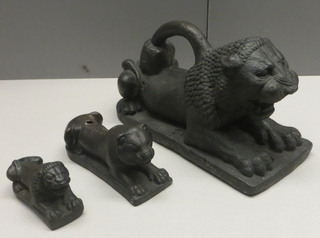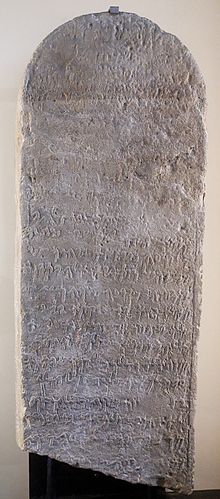
Tayma or Tema is a large oasis with a long history of settlement, located in northwestern Saudi Arabia at the point where the trade route between Medina and Dumah (Sakakah) begins to cross the Nafud desert. Tayma is located 264 km (164 mi) southeast of the city of Tabuk, and about 400 km (250 mi) north of Medina. It is located in the western part of the Nafud desert.

The Nabataean script is an abjad that was used to write Nabataean Aramaic and Nabataean Arabic from the second century BC onwards. Important inscriptions are found in Petra, the Sinai Peninsula, and other archaeological sites including Abdah and Mada'in Saleh in Saudi Arabia.
Lihyan, also called Dadān or Dedan, was a powerful and highly organized ancient Arab kingdom that played a vital cultural and economic role in the north-western region of the Arabian Peninsula and used Dadanitic language. The Lihyanites ruled over a large domain from Yathrib in the south and parts of the Levant in the north.
Kanaanäische und Aramäische Inschriften, or KAI, is the standard source for the original text of Canaanite and Aramaic inscriptions not contained in the Hebrew Bible.

The Assyrian lion weights are a group of bronze statues of lions, discovered in archaeological excavations in or adjacent to ancient Assyria.

The Land of Tema, Te'-ma or Tema Arabic: تيماء and Thaiman) is a place mentioned in the Bible where the descendants of Ishmael's son Tema dwelt. In Hebrew, the name means "south country". It was most likely in northern Saudi Arabia and has been identified with the modern Teima', an oasis which lies about 200 miles (320 km) north of Medina, and some 40 miles (64 km) south of Dumat (Dumah), now known as el-Jauf. Teima' is on the ancient caravan road connecting the Persian Gulf with the Gulf of Aqaba which in antiquity bought wealth to the town. Doughty has described at Teima the ruins of an old city wall 3 miles (4.8 km) in circuit. An Aramaic stele recently discovered, belonging to the 6th century BC, shows the influence of Assyrian in the town. The place is mentioned in the cuneiform inscriptions. The possibility of its being on a trade route is supported by the reference in Job 6:19. It is often associated with the Land of Dumah.
The Baal Lebanon inscription, known as KAI 31, is a Phoenician inscription found in Limassol, Cyprus in eight bronze fragments in the 1870s. At the time of their discovery, they were considered to be the second most important finds in Semitic palaeography after the Mesha stele.

The Corpus Inscriptionum Semiticarum is a collection of ancient inscriptions in Semitic languages produced since the end of 2nd millennium BC until the rise of Islam. It was published in Latin. In a note recovered after his death, Ernest Renan stated that: "Of all I have done, it is the Corpus I like the most."

The Canaanite and Aramaic inscriptions, also known as Northwest Semitic inscriptions, are the primary extra-Biblical source for understanding of the society and history of the ancient Phoenicians, Hebrews and Arameans. Semitic inscriptions may occur on stone slabs, pottery ostraca, ornaments, and range from simple names to full texts. The older inscriptions form a Canaanite–Aramaic dialect continuum, exemplified by writings which scholars have struggled to fit into either category, such as the Stele of Zakkur and the Deir Alla Inscription.

The Yehawmilk stele, de Clercq stele, or Byblos stele, also known as KAI 10 and CIS I 1, is a Phoenician inscription from c.450 BC found in Byblos at the end of Ernest Renan's Mission de Phénicie. Yehawmilk, king of Byblos, dedicated the stele to the city’s protective goddess Ba'alat Gebal.

The Carpentras Stele is a stele found at Carpentras in southern France in 1704 that contains the first published inscription written in the Phoenician alphabet, and the first ever identified as Aramaic. It remains in Carpentras, at the Bibliothèque Inguimbertine, in a "dark corner" on the first floor. Older Aramaic texts were found since the 9th century BC, but this one is the first Aramaic text to be published in Europe. It is known as KAI 269, CIS II 141 and TAD C20.5.

The Neirab steles are two 8th-century BC steles with Aramaic inscriptions found in 1891 in Al-Nayrab near Aleppo, Syria. They are currently in the Louvre. They were discovered in 1891 and acquired by Charles Simon Clermont-Ganneau for the Louvre on behalf of the Commission of the Corpus Inscriptionum Semiticarum. The steles are made of black basalt, and the inscriptions note that they were funerary steles. The inscriptions are known as KAI 225 and KAI 226.

The Abydos graffiti is Phoenician and Aramaic graffiti found on the walls of the Temple of Seti I at Abydos, Egypt. The inscriptions are known as KAI 49, CIS I 99-110 and RES 1302ff.

The Cherchell Neopunic inscriptions are two Neopunic inscriptions on marble discovered in 1875 and 1882 in Cherchell in French Algeria. They are currently in the Louvre, known as AO 1028 and AO 5294.

Julius Euting was a German Orientalist.

The Abu Simbel Phoenician graffiti are a number of Phoenician inscriptions found on one of the colossal legs of the temples at Abu Simbel. They have been compared to the Abydos graffiti. They are known as CIS I 111–113.
The Phoenician Adoration steles are a number of Phoenician and Punic steles depicting the adoration gesture (orans).

The Pricot de Sainte-Marie steles are more than 2,000 Punic funerary steles found in Carthage near the ancient forum by French diplomat Jean-Baptiste Evariste Charles Pricot de Sainte-Marie in the 1870s. The find was dramatic both in the scale—the largest single discovery of Canaanite and Aramaic inscriptions—and also due to the finds almost being lost in the sinking of the French ironclad Magenta at Toulon.

The Ain Nechma inscriptions, also known as the Guelma inscriptions are a number of Punic language inscriptions, first found in 1837 in the necropolis of Ain Nechma, in the Guelma Province of Algeria.
The Pierides Kition inscriptions are seven Phoenician inscriptions found in Kition by Demetrios Pierides in 1881 and acquired by the Louvre in 1885.























